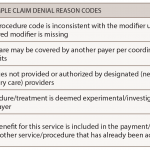Insurance eligibility and authorization are also key components of the patient profile. To avoid denials for insurance coverage and/or obtaining authorization for any procedure that requires it, using payer online tolls to verify eligibility and checking authorization can be an easy approach to minimizing claim rejections. It is a good habit for staff to verify a patient’s benefits before any service is provided and to always get a copy of a patient’s insurance card at each visit.
Coding Errors
With the advent of ICD-10 diagnosis and the Current Procedural Terminology (CPT) coding guidelines and complexity of requirements in a patient’s medical record, coding errors are becoming an increasingly growing cause for claim denials.
Medical necessity is another mounting coding issue. Keep in mind that CPT codes indicate the service performed; and the ICD-10 code gives the reason for the patient being in the practice for service. Some patients may have more than one diagnosis and may need several services. Other patients may need a service that is covered only for a specific diagnosis. A simple coding error in practice is linking the correct diagnosis to an inappropriate CPT code for the office visit or procedure.
Another coding area to monitor is the use of unspecified or nonspecific diagnosis codes. ICD-10 codes consist of three-, four- and five-digit codes. Practices should always verify the diagnosis provided by the physician and bill to the highest level of specificity, because this can be the key to prevent claim denials. Most practices have implemented electronic health records, but it is a good idea to have a coder or claims specialist review claims before final submission to confirm that there are no incomplete or inaccurate codes on the encounter form.
One strategy for prevention and management of coding errors is to identify your practice’s most common diagnosis and service codes and have a cheat sheet for all coding and billing staff to have on hand when reviewing claims.
Claims Submissions
Although claim submission requirements may vary, all payers have a certain timeframe for providers to submit their claims after a service is rendered. It is not uncommon for practices to have a backlog in the billing department, but if claims are not submitted to a payer within the designated timeframe, then the claim is likely to be rejected. Time limits for claim submissions can range from 10–90 days from the date of service. To avoid any mistakes in billing, there should be a list of accepted payers for your practice with their claim-submission requirements. This will need to be a living document and should be monitored and updated based on payer guidelines. It’s also a good idea to have your claims receipt logged in your system in case a payer rejects a claim, citing late submission.



